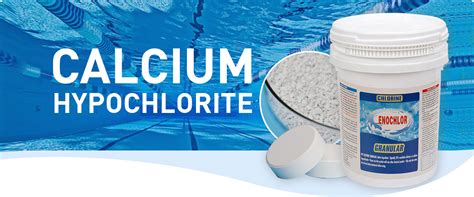The importance of clean drinking water cannot be overstated. In many parts of the world, access to safe and clean drinking water is a luxury that many people cannot afford. The World Health Organization (WHO) estimates that over 2 billion people lack access to safe drinking water, and this can lead to a host of waterborne diseases such as cholera, typhoid, and dysentery. One of the most effective ways to disinfect water is through the use of calcium hypochlorite, a dry and stable form of chlorine that is widely used for water treatment.
What is Calcium Hypochlorite?
Calcium hypochlorite is a chemical compound that is commonly used as a disinfectant in water treatment. It is a dry, white powder that is made up of calcium, oxygen, and chlorine. Calcium hypochlorite is also known as bleaching powder or calcium oxychloride. It is a highly effective disinfectant that is capable of killing a wide range of bacteria, viruses, and other microorganisms that can be found in water.

Benefits of Using Calcium Hypochlorite for Water Disinfection
There are many benefits to using calcium hypochlorite for water disinfection. Some of the most significant advantages include:
- Effective disinfection: Calcium hypochlorite is a highly effective disinfectant that is capable of killing a wide range of bacteria, viruses, and other microorganisms that can be found in water.
- Easy to use: Calcium hypochlorite is a dry powder that is easy to handle and apply to water. It can be added directly to the water or mixed with water to create a solution.
- Cost-effective: Calcium hypochlorite is a cost-effective way to disinfect water, especially when compared to other methods such as ultraviolet (UV) light disinfection or ozone treatment.
- Stable and long-lasting: Calcium hypochlorite is a stable compound that can be stored for long periods of time without losing its effectiveness.
How Does Calcium Hypochlorite Work?
Calcium hypochlorite works by releasing chlorine ions into the water, which then react with and kill microorganisms. The process is as follows:
- Calcium hypochlorite dissolves: When calcium hypochlorite is added to water, it dissolves and releases chlorine ions.
- Chlorine ions react with microorganisms: The chlorine ions then react with and kill microorganisms such as bacteria, viruses, and other pathogens.
- Microorganisms are inactivated: The chlorine ions inactivate the microorganisms, making it impossible for them to reproduce and cause harm.

Steps for Using Calcium Hypochlorite for Water Disinfection
Here are the steps for using calcium hypochlorite for water disinfection:
- Determine the dosage: Determine the correct dosage of calcium hypochlorite to use based on the amount of water to be treated and the desired level of disinfection.
- Mix the calcium hypochlorite with water: Mix the calcium hypochlorite with water to create a solution.
- Add the solution to the water: Add the solution to the water to be treated.
- Wait for the disinfection process to complete: Wait for the disinfection process to complete, which can take anywhere from 30 minutes to several hours depending on the dosage and the desired level of disinfection.
Calcium Hypochlorite Dosage and Usage Rates
The dosage and usage rates for calcium hypochlorite can vary depending on the specific application and the desired level of disinfection. Here are some general guidelines for calcium hypochlorite dosage and usage rates:
- Drinking water treatment: 1-2 grams per liter of water
- Wastewater treatment: 2-5 grams per liter of water
- Swimming pool disinfection: 1-2 grams per 1,000 liters of water

Calcium Hypochlorite Safety Precautions
When handling calcium hypochlorite, it is essential to take certain safety precautions to avoid exposure to the chemical. Here are some safety precautions to follow:
- Wear protective clothing: Wear protective clothing such as gloves, goggles, and a mask when handling calcium hypochlorite.
- Avoid skin contact: Avoid skin contact with calcium hypochlorite, as it can cause irritation and burns.
- Avoid eye contact: Avoid eye contact with calcium hypochlorite, as it can cause irritation and damage.
- Use in well-ventilated areas: Use calcium hypochlorite in well-ventilated areas to avoid inhalation of the chemical.





Conclusion
Calcium hypochlorite is a highly effective disinfectant that is widely used for water treatment. It is a dry, white powder that is made up of calcium, oxygen, and chlorine, and it works by releasing chlorine ions into the water to kill microorganisms. When using calcium hypochlorite, it is essential to follow certain safety precautions to avoid exposure to the chemical. By understanding the benefits, usage rates, and safety precautions of calcium hypochlorite, individuals can effectively use this chemical to disinfect water and prevent waterborne diseases.
What is calcium hypochlorite?
+Calcium hypochlorite is a chemical compound that is commonly used as a disinfectant in water treatment.
How does calcium hypochlorite work?
+Calcium hypochlorite works by releasing chlorine ions into the water, which then react with and kill microorganisms.
What are the benefits of using calcium hypochlorite for water disinfection?
+The benefits of using calcium hypochlorite for water disinfection include effective disinfection, ease of use, cost-effectiveness, and stability.
